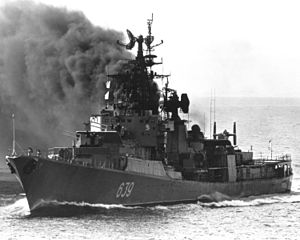
Summary
The Kanin class were a class of destroyers of the Soviet Navy during the Cold War. The Soviet designation was Project 57A Gnevny (not to be confused with the World War II era Project 7). These ships were the first Soviet guided missile destroyers and were initially designated Project 57bis (or 57b) and known to NATO as the Krupny class. Their primary mission was anti-surface warfare using the SS-N-1 anti-ship missile.
 Kanin-class destroyer
| |
| Class overview | |
|---|---|
| Name | Kanin class |
| Operators | |
| Preceded by | Kildin class |
| Succeeded by | Kashin class |
| Built | 1957-1960 |
| In commission | 1960-1993 |
| Planned | 9 |
| Completed | 8 |
| Cancelled | 1 |
| Retired | 8 |
| General characteristics | |
| Type | Guided missile destroyer |
| Displacement |
|
| Length | 126.1 m (414 ft) |
| Beam | 12.7 m (42 ft) |
| Draught | 4.2 m (14 ft) |
| Installed power | 72,000 hp (54,000 kW) |
| Propulsion | 2 × shaft geared steam turbines, 4 boilers, |
| Speed | as built 34.5 knots (63.9 km/h; 39.7 mph) |
| Complement | 320 |
| Sensors and processing systems |
|
| Armament |
|
| Aviation facilities | helicopter pad |
Design edit
Designed from as gun armed destroyers with 3 pairs of 130mm guns, their layout was completed in 1956. However, in February 1957, the incoming chief of staff, Admiral Sergey Gorshkov ordered changes after missile armed versions of the Kotlin class were deemed unsuccessful.[1] Their initial purpose was surface engagement with opposing naval vessels and shore targets. The SS-N-1 missile installed in this class for that specific mission. The destroyers carried two launchers for the SS-N-1, one located at each end of the ship, each magazine holding six additional missiles.[2]
The hull was scaled up from the Kotlin class,[2] and the machinery was the same as those ships, except that remote control stations were installed and electrical generating capacity was increased. The superstructure was made of steel rather than the aluminium/ magnesium alloy of the Kotlin class ships and accommodation was significantly improved.
Criticisms of the class include that they had limited self-defence weaponry and that their main weapon, the SS-N-1 was soon obsolescent after introduction.[2]
ASW conversion edit
The limitations of the SS-N-1 missile were clear by 1965 and the Soviet Navy decided to convert the ships to a more general purpose / ASW role. These ships were called the Kanin class by NATO. This involved providing the destroyers with a new bow sonar, MG-332 Titan-2 that controlled two quintuple torpedo tubes and three RBU-6000s. To clear the bow sonar also required that the bow be extended 5.3 feet (1.6 m). A helicopter pad was installed aft that allowed the ships to operate a Kamov Ka-25 helicopter.[2]
To improve the destroyers' self-defence, launchers firing SA-N-1 anti-air missiles were installed along with two quadruple-mounted 57mm guns.[2] All of these installations required more power and hence, the diesel generator was upgraded to 500 kW and a second generator of that capability was installed. All of this increased the displacement of the ships by 200 tons standard and 308 tons fully loaded and decreased its speed to 32 knots (59 km/h; 37 mph).[2]
According to Conway's the modernisation proved very expensive and appeared to have deterred the Soviets from any further comprehensive rebuilding of older ships.[2]
Operations edit
In May 1975, to commemorate the 30th anniversary of Victory in Europe, Boyky and Zhguchy[3] made a five-day visit to Boston, Massachusetts. This was the first post-war visit by a Soviet naval ship to the United States.
Ships edit
| Kanin-class destroyers[2] | |||||||
|---|---|---|---|---|---|---|---|
| Ship | Russian | Builder | Laid down | Launched | Commissioned | Fleet | Fate |
| Gremyashchy | Гремящий | Zhdanov Shipyard, Leningrad | 25 February 1958 | 30 April 1959 | 30 June 1960 | Northern Fleet | Decommissioned 1991 |
| Zhguchy | Жгучий | 23 June 1958 | 14 October 1959 | 23 December 1960 | Northern Fleet | Decommissioned 1987 | |
| Zorky | Зоркий | 17 April 1959 | 30 April 1960 | 30 September 1961 | Baltic Fleet | Decommissioned 1993 | |
| Derzky | Дерзкий | 10 October 1959 | 4 February 1960 | 30 December 1961 | Northern Fleet | Decommissioned 1990 | |
| Gnevny | Гневный | North Nikolayev Shipyard, Mykolaiv | 17 December 1957 | 30 November 1958 | 10 January 1960 | Black Sea Fleet (Pacific Fleet from 1970) | Decommissioned 1988 |
| Uporny | Упорный | 9 April 1958 | 14 October 1959 | 3 December 1960 | Pacific Fleet | Decommissioned 1993 | |
| Boyky | Бойкий | 2 April 1959 | 15 December 1959 | 16 June 1961 | Black Sea Fleet | Decommissioned 1988 | |
| Gordy | Гордый | Amur Shipbuilding Plant, Komsomolsk-on-Amur | May 1959 | 15 December 1960 | 6 February 1961 | Pacific Fleet | Decommissioned 1987 |
| Khrabry | Храбрый | 1959 | 1961 | Cancelled 1963 | Completed as a stationary power generation ship "ЭНС-73" in 1969 and out of service in 1982 | ||
See also edit
Notes edit
References edit
- Gardiner, Robert (ed.); Chumbley, Stephen; Budzbon, Przemysław (1995). Conway's All the World's Fighting Ships 1947–1995. Annapolis, MD: Naval Institute Press. ISBN 1-55750-132-7. OCLC 34267261.
{{cite book}}:|first1=has generic name (help) - Project 57 Krupnyy Project 57A Kanin, Federation of American Scientists, 7 September 2000, retrieved 26 December 2014
- "Kanin Class Destroyers – Complete Ship List". Russian-ships.info. Retrieved 26 December 2014.
In Russian edit
- Соколов А. Н. (2007). Расходный материал флота. Миноносцы СССР и России. М.: Военная книга. ISBN 978-5-902863-13-7.
External links edit
- Page from Navycollection (in Russian)


